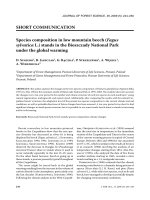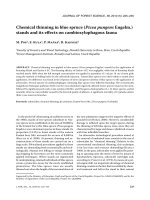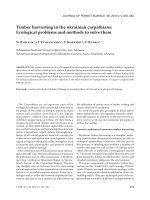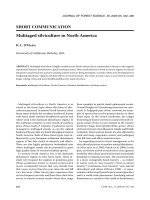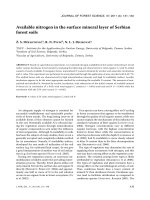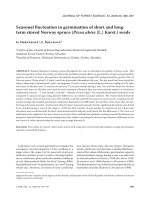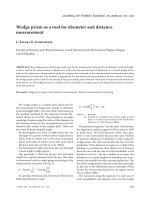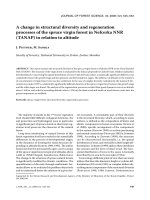Báo cáo lâm nghiệp: "Sexual reproduction in Populus I. Some physiological and biochemical events of the progamic phase" pdf
Bạn đang xem bản rút gọn của tài liệu. Xem và tải ngay bản đầy đủ của tài liệu tại đây (121.39 KB, 3 trang )
Sexual
reproduction
in
Populus
I.
Some
physiological
and
biochemical
events
of
the
progamic
phase
M.
Villar
1
M.
Gaget
2
D’Amélioration
C.
Dumas
2
1
INRA,
Station
dAm6lioration
des
Arbres
Forestiers,
Ardon,
F-45160
Olivet,
and
2
Laboratoire
de
Reconnaissance
Cellulaire
et
Am6lioration
des
Plantes,
INRA
23879,
Université
Lyon
I,
43,
bd
11-Novembre-1918,
F-69622
Villeurbanne
Cedex,
France
Introduction
Hybridization
in
Populus
breeding
pro-
grams
is
limited
by
sexual
incompatibility
barriers,
whose
cellular
and
molecular
mechanisms
are
not
yet
known.
In
an
attempt
to
understand
the
nature
of
inter-
specific
incompatibility
in
Populus,
we
have
explored
the
interactions
between
male
and
female
partners
(pollen-pistil)
in
compatible
and
incompatible
crosses
P.
nigra
(female)
x
P.
nigra
(male)
and
P.
nigra
(female)
x
P.
alba
(male)
(Villar,
1987).
Materials
and
Methods
P.
nigra
and
P.
alba
branches
were
obtained
from
the
INRA
Forestry
station
in
Or[6ans
(France).
Pollen
was
collected
and
stored
in
closed
vials
at
-18°C.
Kinetics
of
pollen
tube
growth
in
vivo
were
studied
in
growth
chambers
(20°C).
Pollen
tubes
in
the
stylar
tissues
were
visualized
using
the
aniline
blue
fluorescence
method
(ABF
method,
Dumas
and
Knox,
1983).
Isoelectric
focusing
(IEF)
of
pollinic
and
stig-
matic
proteins,
gel
preparation,
focusing
condi-
tions,
silver
nitrate
staining
and
homogenates
of
pollinated
stigma
were
performed
according
to
the
procedures
ot’
Villar
et
al.
(1988).
Each
of
the
2
crosses
was
represented
by
3
series
of
stigmatic
extract!.,
in
accordance
with
the
growth
kinetics
(0.6
and
20
h
after
pollination).
Protein
patterns
of
these
extracts
were
com-
pared
on
a
single
gel.
Glycoprotein
revelation
(concanavalin
A-binding
proteins)
on
IEF
poly-
acrylamide
gel
was
adapted
from
Hawkes
(1982).
j3-Ga!actosidase
visualization
was
op-
timized
from
the
protocol
of
Singh
and
Knox
(1985).
Results
and
Dis;cussion
Kinetics
of
pollen
tube
growth
(visualiza-
tion
using
the
AI3F
method)
have
demon-
strated
distinct
behaviors
of
P
nigra
and
P
alba
pollen
tubes
inside
P
nigra
pistils
(Fig.
1
P
alba
pollen
tubes
exhibit
a
unique
S-shaped
growth
curve
and
an
arrested
growth
near
the
stylodium.
On
the
other
hand,
P
nigra
pollen
tubes
ex-
hibit
2
growth
phases,
respectively,
in
the
stigmatic
tissues
and
in
the
ovarian
cavity.
P,
nigra
and
P
alba
curves
diverge
5
h
after
pollination
(20°C),
corresponding
precisely
to
the
deposition
of
the
first
callose
plug
inside
pollen
tubes.
This
divergence
could
likely
be
related
to
a
change
in
the
physiology
of
the
compat-
ible
pollen
tube,
shifting
from
an
auto-
trophic
to
a
heterotropic
type
of
nutrition.
Biochemical
studies
focused
on
pollinic
and
stigmatic
proteins,
known
to
be
in-
volved
in
male-female
interactions
(Gaude
and
Dumas,
1987).
After
silver
nitrate
staining,
qualitative
and
quantita-
tive
differences
could
be
observed,
related
to
the
presence
of
P
nigra
and
P
alba
pol-
len
tubes
inside
stigmatic
tissues.
How-
ever,
increasing
protein
bands
were
detectable,
0-20
h
after
pollination,
only
in
compatible
pollinated
stigmas.
The
conca-
navalin
A-peroxidase
reaction
allowed
the
visualization
of
15
stigmatic
and
pollinic
glycoproteins.
Differences
were
observed,
according
to
the
type
of
cross:
one
distinct
glycoprotein
increases
only
in
the
compat-
ible
cross.
Moreover,
f3-Galactosidase
ac-
tivities
were
revealed
with
a
similar
electrophoretic
technique
in
pollinated
stigma.
This
pollinic
enzyme
could
play
a
role
in
heterotropic
pollen
tube
nutrition
(Singh
and
Knox,
1985).
An
increase
of
its
activity
(one
isoenzyme
of
isoelectric
point
about
pH
4.2)
from
6-20
h
after
pollination
was
detected
only
in
the
compatible
cross.
Conclusion
The
compatible
progamic
phase
in
P.
nigra,
i.e.,
pollen
tube
growth
up
to
the
embryo
sac,
could
be
related
to
pollinic
enzymes
involved
in
pollen
tube
metabo-
lism,
such
as
¡3-galactosidase.
Its
activity
could
be
the
final
result
of
a
series
of
inter-
actions
started
by
initial
pollen-stigma
communications.
This
dialogue
probably
implicates
protein
compounds,
detected
in
pollen
and
pollen
tube
diffusates
in
vitro
(Villar,
1987;
Gaget,
1988).
References
Dumas
C.
&
Knox
R.B.
(1983)
Callose
and
determination
of
pistil
viability
and
incompatibili-
ty.
Theor.
AppL
Genet.
67, 1-10
0
Gaget
M.
(1988)
incompatibility
intersp6cifique
chez
Populus:
effet
Mentor.
Ph.D.
Thesis,
Uni-
versite
Lyon
I,
France
Gaude
T.
&
Dumas
C.
(1987)
Molecular
and
cellular
events
of
self-incompatibility.
Int.
Rev.
Cytol.
107,333-366
Hawkes
R.
(1982)
Identification
of
concanavalin
A-binding
proteins
after
sodium
dodecyl
sul-
fate-gel
electrophoresis
and
protein
blotting.
AnaL
Biochem.
4
23, 143-146
Singh
K.
and
Knox
R.B.
(1985)
P-Galactosidase
of
Lilium
pollen.
Phytochemistry
24,
1639-1643
Villar
M.
(1987)
Incompatibilit6
intersp6cifique
chez
Populus:
approches
physiologique
et
biochimique.
Phi.D.
Thesis,
Universit6
Lyon
I,
France
Villar
M.,
Gaget
M.
&
Dumas
C.
(1988)
Micro-
isoelectric
focusing
of
proteins
from
single
stig-
ma
in
Populus.
Can.
J.
For.
18, 1261-1264

